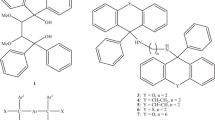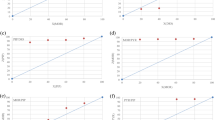Abstract
The host compound 3,3′-bis (9-hydroxy-9-fluorenyl)-2,2′-binaphthyl formed three inclusion compounds H.2PYR (1), H.2MOR (2) and H.PYR/MOR (3) with pyridine (PYR), morpholine (MOR) and their equimolar mixture, respectively. 1 crystallized in the triclinic space group P-1 with a = 11.4201(2), b = 13.2910(2), c = 16.2395(2) Å, α = 106.78(1), β = 99.11(1), γ = 112.34(1)o. 2 crystallized in the monoclinic space group P21/c with a = 9.8109(8), b = 38.740(3), c = 11.6655(9) Å, β = 108.444(2)o. 3 crystallized in the triclinic space group P-1with a = 11.4342(3), b = 13.4093(4), c = 16.1414(6) Å, α = 106.520(15), β = 98.760(18), γ = 112.390(16)o. The crystal structures of the three inclusion compounds were elucidated and their thermal behaviour was analysed by thermal gravimetry, differential scanning calorimetry and hot stage microscopy. Thermal analysis of the inclusion compounds showed that the guest desorption occurred in two steps with the free guest released at the first step followed by that of hydrogen-bonded guest. The measure of stability of the inclusion compounds derived from thermal analysis revealed that 1 is more stable than 2. In 3, even though there are two different competitive guest molecules (PYR and MOR) present in the structure PYR is preferably encapsulated within the molecular cage, presumably because it is the preferred H-bond acceptor.
Graphical Abstract
The host compound 3,3′-bis (9-hydroxy-9-fluorenyl)-2,2′-binaphthyl formed inclusion compounds with pyridine and morpholine and their equimolar mixture. The crystal structures of the three inclusion compounds were elucidated and their thermal stabilities were analysed by thermal gravimetry, differential scanning calorimetry and hot stage microscopy.












Similar content being viewed by others
References
Weber E (1991) In: Atwood JL, Davies JED, MacNicol DD (eds) Inclusion compounds. Oxford University Press, Oxford, p 188
Toda F, Bishop R (2004) Separations and reactions in organic supramolecular chemistry. Perspectives in supramolecular chemistry. Wiley, Chichester
Arad-Yellin R, Green BS, Knossow M, Tsoucaris G (1984) Enantiomeric selectivity of host lattices, Inclusion Compounds. Academic Press, New York, p 263
Caira MR, Horne A, Nassimbeni LR, Toda F (1997) J Mater Chem 7:2145
Bond DR, Johnson L, Nassimbeni LR, Toda F (1991) J Solid State Chem 92:68
Caira MR, Le Roex T, Nassimbeni LR, Ripmeester JA, Weber E (2004) Org Biomol Chem 2:2299
Weber E (1987) Topics in current chemistry, vol 140. Springer-Veslag, Berlin
Weber E, Menihold D, Haase R, Seidite W, Rheinwald G (2005) Supramol Chem 17:303
Meinhold D, Seichter W, Köhnke K, Seidel J, Weber E (1997) Adv Mater 9:958
Haase R, Meinhold DS, Thomas B, Weber E, Rheinwald G (2002) Struct Chem 13:471
Nassimbeni LR, Marivel S, Su H, Weber E (2013) RSC Adv 3:25758
COLLECT (2000) data collection software: Nonius BV Delft, The Netherlands
Otwinowski Z, Minor W (1997) Methods Enzymol 276:307
Bruker (2004) SAINT-Plus (including XPREP) Version 7.12. Bruker AXS Inc, Madison, Wisconsin, USA
Bruker (2003) XPREP2 Version 6.14. Bruker AXS Inc, Madison, Wisconsin, USA
Sheldrick GM (2008) Acta Crystallogr A64:112
Barbour LJ (2001) J Supramol Chem 1:189
Spek AL (2009) Acta Crystallogr D65:148
Mercury 3.1 (2009) Supplied with Cambridge Structural Database CCDC: Cambridge UK
Nishio M, Umezawa Y, Honda K, Tsuboyama S, Suezawa H (2009) CrystEngComm 11:1757
Caira MR, Nassimbeni LR, Niven ML, Schubert W-D, Weber E, Dorpinghaus N (1990) J Chem Soc Perkin Trans 2 12:2129
Acknowledgments
M. S. thanks the Claude Leon Foundation for a Postdoctoral Fellowship. We thank the National Research Foundation (Pretoria) and the University of Cape Town for research funds.
Author information
Authors and Affiliations
Corresponding author
Rights and permissions
About this article
Cite this article
Samipillai, M., Nassimbeni, L.R. & Weber, E. Pyridine and Morpholine Inclusion by a Binaphthyl Host. J Chem Crystallogr 44, 293–300 (2014). https://doi.org/10.1007/s10870-014-0513-7
Received:
Accepted:
Published:
Issue Date:
DOI: https://doi.org/10.1007/s10870-014-0513-7




